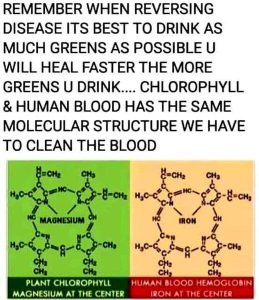
I know of no clinical trials that prove this but both Max Gerson and Rudolf Breuss were able to attain a remission in cancer patients using vegetable juices so there may be something in this.
Just checked grok.com which responded:
No, chlorophyll and human blood do not have the same molecular structure. Chlorophyll is a green pigment found in plants, algae, and some bacteria, used in photosynthesis, while human blood is a complex fluid containing cells, proteins, and other molecules, with hemoglobin as the primary oxygen-carrying component.
To clarify the comparison, it’s likely you’re referring to the molecular structures of chlorophyll and hemoglobin, as they are sometimes compared due to superficial similarities. Here’s a concise breakdown:
- Chlorophyll: A class of molecules (e.g., chlorophyll a, C55H72O5N4Mg) with a porphyrin ring structure centered around a magnesium ion. It absorbs light, primarily in the blue and red wavelengths, for photosynthesis.
- Hemoglobin: A protein in red blood cells containing four heme groups, each with a porphyrin ring centered around an iron ion (Fe2+). Its molecular formula is complex (C2952H4664N812O832S8Fe4 for adult hemoglobin), and it transports oxygen in the blood.
Key Similarities:
- Both have a porphyrin ring, a large cyclic structure with conjugated double bonds.
- Both use a metal ion at the center of the porphyrin (magnesium in chlorophyll, iron in hemoglobin).
Key Differences:
- Metal Ion: Chlorophyll uses magnesium; hemoglobin uses iron.
- Molecular Complexity: Chlorophyll is a single molecule; hemoglobin is a large protein with four subunits, each containing a heme group.
- Function: Chlorophyll captures light energy; hemoglobin binds and transports oxygen.
- Side Chains: The porphyrin rings in each have different side groups, tailoring their chemical properties to their respective functions.
- Environment: Chlorophyll operates in plant chloroplasts; hemoglobin functions in animal blood.
In summary, while chlorophyll and hemoglobin share a porphyrin ring core, their overall molecular structures, functions, and compositions are distinct.
